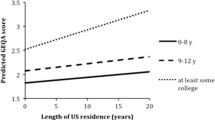Abstract
There are few validated acculturation measures for Asian Indians in the U.S. We used the 2004 California Asian Indian Tobacco Survey to examine the relationship between temporal measures and eleven self-reported measures of acculturation. These items were combined to form an acculturation scale. We performed psychometric analysis of scale properties. Greater duration of residence in the U.S., greater percentage of lifetime in the U.S., and younger age at immigration were associated with more acculturated responses to the items for Asian Indians. Item-scale correlations for the 11-item acculturation scale ranged from 0.28–0.55 and internal consistency reliability was 0.73. Some support was found for a two-factor solution; one factor corresponding to cultural activities (α = 0.70) and the other to social behaviors (α = 0.59). Temporal measures only partially capture the full dimensions of acculturation. Our scale captured several domains and possibly two dimensions of acculturation.

Similar content being viewed by others
References
Martin P, Midgley E. Immigration: shaping and reshaping America. Population. 2003;58(2):1–46.
Argeseanu Cunningham S, Ruben JD, Venkat Narayan KM. Health of foreign-born people in the United States: a review. Health Place. 2008;14(4):623–35.
Salant T, Lauderdale DS. Measuring culture: a critical review of acculturation and health in Asian immigrant populations. Soc Sci Med. 2003;57(1):71–90.
Thomson MD, Hoffman-Goetz L. Defining and measuring acculturation: a systematic review of public health studies with Hispanic populations in the United States. Soc Sci Med. 2009;69(7):983–91.
Gordon MM. Assimilation in American life: the role of race, religion, and national origins. New York: Oxford University Press; 1964.
Berry J, Sam D. Acculturation and adaptation. In: Berry JW, Segal MH, Kagitcibasi C, editors. Handbook of cross-cultural psychology: social behavior and applications, vol. 3. Boston, MA: Allyn and Bacon; 1997. p. 291–326.
Kramer EM. Dimensional accrual and dissociation: an introduction. In: Grace J, Kramer EM, editors. Communication, comparative cultures, and civilizations, vol. 3. New York: Hampton; 2013. p. 123–84.
Kramer EM. Theoretical reflections on intercultural studies: preface. In: Croucher S, editor. Looking beyond the hijab. Cresskill, NJ: Hampton; 2008.
Abe-Kim J, Okazaki S, Goto SG. Unidimensional versus multidimensional approaches to the assessment of acculturation for Asian American populations. Cultur Divers Ethnic Minor Psychol. 2001;7(3):232–46.
Mogelonsky M. Asian-Indian Americans. Am Demogr. 1995;17(8):32–9.
McCarthy WJ, Divan HA, Shah DB. Immigrant status and smoking. Am J Public Health. 2003;93(10):1616; author reply 1616–1617.
Chung G, Ruth H, Kim B, Abreu J. Asian American multidimensional acculturation scale: development, factor analysis, reliability, and validity. Cultur Divers Ethnic Minor Psychol. 2004;10(1):66–80.
Suinn RM, Ahuna C, Khoo G. The Suinn-Lew Asian self-identity acculturation scale: concurrent and factorial validation. Educ Psychol Meas. 1992;52(4):1041–6.
Barnes PM, Adams PF, Powell-Griner E. Health characteristics of the Asian adult population: United States, 2004–2006. Advance data from vital and health statistics; no 394. Hyattsville, MD: National Center for Health Statistics; 2008.
McCarthy WJ, Divan H, Shah D, et al. California Asian Indian Tobacco Survey: 2004. Sacramento, CA: California Department of Health Services; 2005.
Lauderdale DS, Kestenbaum B. Asian American ethnic identification by surname. Popul Res Policy Rev. 2000;19(3):283–300.
Hays RD, Revetto JP. Old and new MMPI-derived scales and the short-MAST as screening tools for alcohol disorder. Alcohol Alcohol. 1992;27(6):685–95.
Hays R, Fayers P. Evaluating multi-item scales. In: Fayers PM, Hays RD, editors. Assessing quality of life in clinical trials: methods and practice. New York: Oxford University Press; 2005. p. 41–53.
Hu L, Bentler PM. Cutoff criteria for fit indexes in covariance structure analysis: conventional criteria versus new alternatives. Struct Equ Model. 1999;6(1):1–55.
Williams D, Mohammed S. Discrimination and racial disparities in health: evidence and needed research. J Behav Med. 2009;32(1):20–47.
Mehta S. Relationship between acculturation and mental health for Asian Indian immigrants in the United States. Genet Soc Gen Psychol Monogr. 1998;124(1):61–78.
Nunnally Jum C, Bernstein Ira H. Psychometric theory. New York: McGraw-Hill; 1978.
Nguyen HH, von Eye A. The acculturation scale for Vietnamese adolescents (ASVA): a bidimensional perspective. Int J Behav Dev. 2002;26(3):202–13.
Abraido-Lanza AF, Armbrister AN, Florez KR, Aguirre AN. Toward a theory-driven model of acculturation in public health research. Am J Public Health. 2006;96(8):1342–6.
Baker D. Conceptual parameters of acculturation within the Asian and pacific islander American populations: applications for nursing practice and research. Nurs Forum. 2011;46(2):83–93.
Hunt LM, Schneider S, Comer B. Should “acculturation” be a variable in health research? A critical review of research on US Hispanics. Soc Sci Med. 2004;59(5):973–86.
Pourat N, Kagawa-Singer M, Breen N, Sripipatana A. Access versus acculturation: identifying modifiable factors to promote cancer screening among Asian American women. Med Care. 2010;48(12):1088–96.
Acknowledgments
NB was supported by the National Research Service Award (T32 PE19001), and the American Heart Association—Pharmaceutical Roundtable Spina Outcomes Center (0875133N), Fellowships at the University of California, Los Angeles. RDH was supported in part by grants from the NIA (P30-AG021684) and the NIMHD (2P20MD000182). WJM was supported by the NHLBI—1P50HL105188-6094.
Author information
Authors and Affiliations
Corresponding author
Rights and permissions
About this article
Cite this article
Bharmal, N., Hays, R.D. & McCarthy, W.J. Validity of Temporal Measures as Proxies for Measuring Acculturation in Asian Indian Survey Respondents. J Immigrant Minority Health 16, 889–897 (2014). https://doi.org/10.1007/s10903-013-9837-1
Published:
Issue Date:
DOI: https://doi.org/10.1007/s10903-013-9837-1



